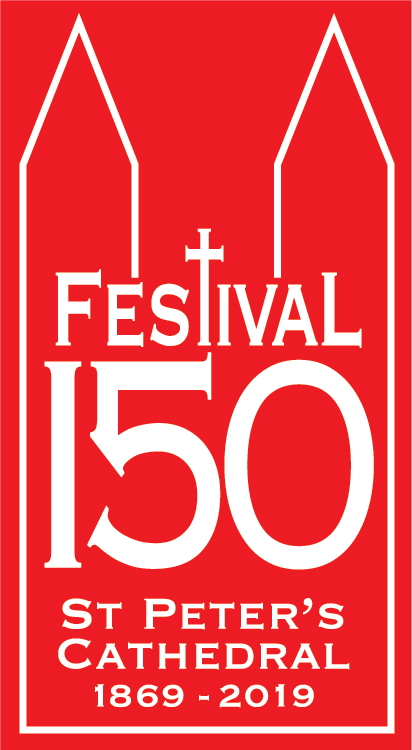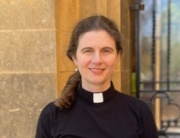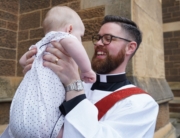
Patronal 150: A sermon by The Very Rev’d Frank Nelson
Psalm 145: 1- 10
Sirach 44: 1- 15
1 Corinthians 3: 10 – 17
It’s been quite a time – this Festival 150 weekend as we have marked the one hundred and fiftieth anniversary of the laying of the foundation stone of St Peter’s Cathedral by Bishop Augustus Short. It began earlier in the week when I fetched Short’s funerary hatchment – seen hanging down there on the south wall. Being ignorant of what a hatchment is it was like an unexpected birthday present not knowing what would be under the thick folds of bubble wrap. We are indebted to Mrs Doff Short, widow of Henry Short, the last known male “Short” descendent of the good Bishop. And then, like the party cake that hasn’t yet arrived, there was my anxiety as the week went on and the commemoration stone still had not arrived. Several unanswered phone calls finally established that the stone engraver was ill and in hospital. “Don’t worry, he assured us. All will be well. I’ll have it in place.”
Thursday came, Friday came, Saturday morning came – still no sign of the stone. Finally in pouring rain late yesterday afternoon the stone arrived, ready to be dropped into place once the pavers were lifted out of their bed of sand. Only – the bed of sand turned out to be solid concrete. Three hours later, with the Port footy game opposite well underway, the stone was finally in place – ready for the Governor to unveil this morning!
Celebrations – those times when family and friends gather – are times for stories. Stories told about the person or event being celebrated. Stories that sometimes grow in the telling, or become sanitised of those things we’d rather not remember.
Speaking at the early morning Eucharist here last Thursday Bishop Chris suggested there are two types of stories in families – the parent stories, and the grandparent stories. Parent stories go something like this: Parent to child, “We had it tough. My bedroom had to be tidy at all times, we only ever had bread and jam for school lunches, and, at age 16, a night-time curfew of 10pm.” Grandparent stories goes more like this: Grandparent to child in front of grandchild, “You’d never guess that your father – look at him in his priest’s robes – was lucky the shop-keeper did not press charges over those ice-creams found in his pockets! Your grandmother was forever nagging him about tidying up his room, getting on with music practice or turning down the volume of the latest hit-single. And do you know, after driving around for hours in the wee small hours, frantically searching for your dad who had gone off with his scouting friends, I eventually returned home to find him fast asleep on the couch, reeking of cheap wine.”
I never had the privilege of having grandparents alive long enough to tell me these stories. But I do remember well having to ‘correct’ the stories told by my sisters to our fifteen year old daughter when she returned from a summer holiday spent with her overseas aunts. The reality is seldom as nice and tidy as we would like it to be.
The paper record, the bare facts recorded in Cathedral Council, Synod or other minutes are baldly stated – the final outcome of many hours of discussion, sometimes bitter and accusatory.
Not even the most carefully researched book by a Michael Whiting on a Bishop Short can possibly tell the whole story of a person’s life. The wonderful old photos we have dug up in the archives and posted to the Cathedral’s facebook pages in recent months, or those you see around you on display tonight, the written words, the masterful pen strokes, the view through a camera lens, memory stories captured in writing – these give a snapshot of a moment in the history of a building, a people.
Never the whole story. For that – we need the grandparent version. The stories our Cathedral welcomers hear when visitors come in on a rainy day and talk about how their great grandfather was a stone mason or roofer who cut his teeth on the Cathedral; the sort of stories that came out following Friday’s live ABC Radio broadcast from the nave platform – when David Bevan invited people to text or email their stories about St Peter’s Cathedral.
The difference between these two types of stories is rather like the writings of Sirach compared to those of St Paul. Tonight’s reading from Sirach, Ecclesiasticus 44, offers a litany of the achievements of the great and famous. We have that sort of story in our Cathedral records, engraved in wood and stone and silver in this building – on the pews you are sitting on, the chalices we used this morning, even the lectern from which Canons William and Mara read tonight. Paul, I often think, was a bit more honest – the real messy life of a congregation is more evident in his writings, the scrappy one-upmanship arguments that so bedevil churches, the petty jealousies over flowers and who sits where or walks behind or in front of whom in procession. Over the years these are ironed out and largely forgotten, or, like a good grandparent story, told to future generations slightly tongue in cheek.
I have always enjoyed the apparent throwaway comment of St John when, towards the end of his Gospel, he reminds readers that ‘Jesus did many other signs … which are not recorded in this book’ (John 20: 30) John selected signs to tell a story – his version of a story. We do the same – whether as parents and grandparents, canons lay or ordained, cathedral tour guides, even deans and archbishops. A community has a narrative that shapes and informs it into the future. Yes, it draws on the past – it is important to celebrate the past, ‘to sing the praises of the famous’ – but we should also acknowledge the past honestly – perhaps especially the painful and shameful episodes of our history. But, thanks be to God, we don’t need to stay in the past. We can actually be quite proactive about imagining the future.
And that is something we are trying to do in this Cathedral Festival 150 year. Bishop Jeremy Greaves and Archbishop Kay Goldsworthy will be preaching here over the next few months under the title “Bishops imagine the future.” I look forward to engaging in their thinking and challenge. And in late September a Creation Care Seminar will be offered with, among other presenters, Theo McCall and Vicky Balabanski.
Two years ago, when the Cathedral congregation worshipped at St John’s Halifax Street for a month while the organ was being removed for restoration (and doesn’t it sound beautifully now?) a member of that congregation asked me whether I thought the Cathedral had a future. I was quite taken aback. It had never occurred to me to question that there would not, could not, be a future for St Peter’s Cathedral! But it’s a good question, and one we need to ask – not just of the Cathedral, but of our churches and Diocese.
What sort of future will that be – the one we are busy creating now? The one in which today’s actions and decisions and blind-spots will be judged by tomorrow’s standards? When asked a similar question by David Bevan last Friday, I wondered aloud how Adelaide might react if we said, actually, this building, beautiful and iconic as it is, is simply too big, too cold, too expensive, gives all the wrong messages – we’ll just walk away from it. Imagine India playing Australia and there being no reference to bowling from the Cathedral end. Imagine the cyclists in the final sprint of the Tour Down Under and their being no Cathedral spires in the shot up King William Road. Imagine there being no Mother Church for us to gather in as a Diocese, to look back as the place of our ordination, confirmation, school carol service – a place of both celebration and lament for church, city and South Australia.
It’s often been said that the church is only one generation away from extinction and the same is true of a cathedral. We are privileged to have been bequeathed this beautiful building, a sacred space where all are welcomed, where the praises of God are sung, where people come to faith in Jesus Christ, where the very architecture, stained glass windows and carvings, even the smell – says something about the holy.
A place where, as happened yesterday and again today, the bells ring out across the city echoing the ancient cry of the angels at Bethlehem, “Glory to God in the highest and peace to God’s people on earth,” or on Anzac Day with their solemn tolling for the dead of yesteryear and today. All this comes with a cost of course – and this Diocese of Adelaide, through Synod, and now with the help of the Cathedral Chapter, has committed to ensuring there is a future for St Peter’s Cathedral.
Tonight’s service is a formal one, one in a style that has stood the test of hundreds of years, yet is not to everyone’s taste. Before enjoying the Cathedral Choir singing Benjamin Britten’s ‘Hymn to Saint Peter’, let’s pause for a less formal moment and stand to sing joyfully, perhaps even raucously, and certainly in harmony, a birthday greeting to our Cathedral, your Cathedral, my Cathedral. It’s not everyone who gets to be invited to the one hundred and fiftieth birthday bash of a Cathedral.
Sing – Happy Birthday!





